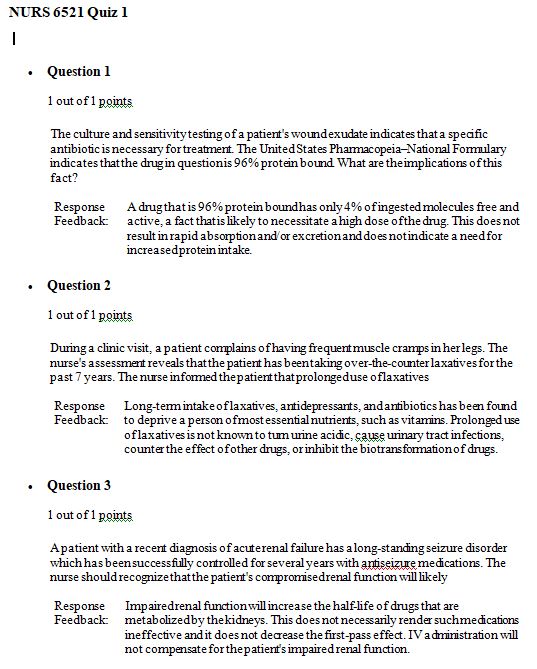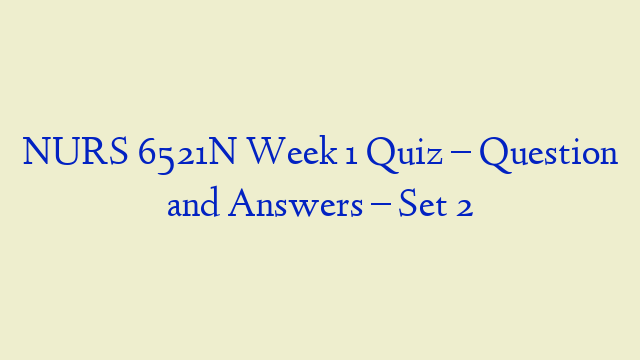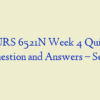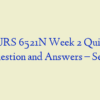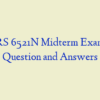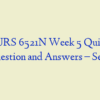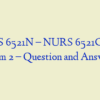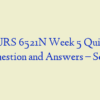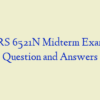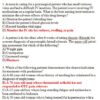Description
NURS 6521 Week 1 Quiz 2 – Question with Answers
- The culture and sensitivity testing of a patient’s wound exudate indicates that a specific antibiotic is necessary for treatment. The United States Pharmacopeia–National Formulary indicates that the drug in question is 96% protein bound. What are the implications of this fact?
- During a clinic visit, a patient complains of having frequent muscle cramps in her legs. The nurse’s assessment reveals that the patient has been taking over-the-counter laxatives for the past 7 years. The nurse informed the patient that prolonged use of laxatives
- A patient with a recent diagnosis of acute renal failure has a long-standing seizure disorder which has been successfully controlled for several years with antiseizure medications. The nurse should recognize that the patient’s compromised renal function will likely
- A patient has been prescribed several drugs and fluids to be given intravenously. Before the nurse starts the intravenous administration, a priority assessment of the patient will be to note the
- A nurse is caring for a patient who has had part of her small intestine removed due to cancer. She has also now developed hypertension and has been prescribed a new medication to decrease her blood pressure. While planning the patient’s care, the nurse should consider a possible alteration in which of the following aspects of pharmacokinetics?
- A patient who has been admitted to the hospital for a mastectomy has stated that she has experienced adverse drug effects at various times during her life. Which of the following strategies should the nurse prioritize in order to minimize the potential of adverse drug effects during the patient’s stay in the hospital?
- A home health nurse notes that there have been changes to a patient’s oral drug regimen. The nurse will closely monitor the new drug regimen to
- A patient is treated with an antibiotic for an infection in his leg. After 2 days of taking the antibiotic, the patient calls the clinic and reports that he has a rash all over his body. The nurse is aware that a rash can be an adverse effect of an antibiotic and can be either a biologic, chemical, or physiologic action of the drug, which is an example of
- A patient has been prescribed 1 mg lorazepam (Ativan) sublingual prior to the scheduled insertion of a peripherally inserted central (PIC) line. How should the nurse direct the patient when administering this medication?
- A 56-year-old female patient has been admitted to the hospital with chronic muscle spasms and has been prescribed a new medication to treat the spasms. She has a poorly documented allergy to eggs, synthetic clothes, and perfumes. What is the priority action of the nurse to ensure that prescribed medication does not experience an allergic reaction?
- An older adult patient with a history of Alzheimer’s disease and numerous chronic health problems has been prescribed several medications during his current admission to hospital and recent declines in the patient’s cognition have impaired his ability to swallow pills. Which of the following medications may the nurse crush before administering them to this patient?
- The nurse’s assessment of a community-dwelling adult suggests that the client may have drug allergies that have not been previously documented. What statement by the client would confirm this?
- Talwin given in combination with Vistaril diminishes the adverse effects of nausea caused by the Talwin. This drug interaction affecting the pharmacodynamics of the Talwin is nurs 6521 week 1 quiz
- 30 ml = _______2________tbsp
- A 60-year-old African-American man lives with a number of chronic health problems. Genetic factors are likely to influence his etiology and/or treatment of
- A nurse is discussing with a patient the efficacy of a drug that his physician has suggested, and he begin taking. Efficacy of a drug means which of the following?
- Which of the following statements best defines how a chemical becomes termed a drug?
- A nurse is instructing a patient concerning a newly prescribed drug. Which of the following should be included to help improve patient compliance and safety?
- A mother brings her 4-year-old child, who is vomiting and has a temperature of 103°F into the emergency department (ED). The ED physician orders acetaminophen (Tylenol) for the fever. The best form of Tylenol to give the child, considering her presentation, would be
- A nurse is caring for a patient who has recently moved from Vermont to south Florida. The patient has been on the same antihypertensive drug for 6 years and has had stable blood pressures and no adverse effects. Since her move, however, she reports “dizzy spells and weakness” and feels that the drug is no longer effective. The nurse suspects that the change in the effectiveness of the drug is related to nurs 6521 week 1 quiz
- Tylenol 325 mg/tablet, patient needs 650 mg; how many tablets should patient take?
- The nurse is caring for a patient receiving an aminoglycoside (antibiotic) that can be nephrotoxic. Which of the following will alert the nurse that the patient may be experiencing nephrotoxicity?
- A patient has been receiving regular doses of an agonist for 2 weeks. Which of the following should the nurse anticipate?
- In light of her recent high blood pressure readings, a patient has been started on a thiazide diuretic and metoprolol (Lopressor), which is a beta-adrenergic blocker. What is the most likely rationale for using two medications to address the patient’s hypertension?
- Which of the following affects drug distribution throughout the body?
- Before the administration of morphine to a 65-year-old man who has cancer, the initial action of the nurse would be to check the patient’s nurs 6521 week 1 quiz
- An older adult who lives in a long-term care facility has recently begun taking losartan (Cozaar) for the treatment of hypertension. The nurse who provides care for this resident should recognize that this change in the resident’s medication regimen make create a risk for
- A nurse is caring for a 73-year-old man who is receiving drug therapy. He is beginning to exhibit signs of decline in his renal system, yet his current serum creatinine level is normal. The nurse will base the patient’s plan of care on the understanding that there is
- Mr. Lacuna is an 83-year-old resident of a long-term care facility who has a diagnosis of moderate Alzheimer disease. Mr. Lacuna’s physician recently prescribed oral rivastigmine, but he was unable to tolerate the drug due to its gastrointestinal effects. As a result, he has been ….the transdermal patch form of the medication. When administering this form of rivastigmine, the nurse should
- Medication reconciliation of an 82-year-old man who has recently moved to a long-term care facility reveals that the man takes 1 to 2 mg of lorazepam bid prn. The nurse should recognize what consequence of this aspect of the resident’s drug regimen?
- A 70-year-old woman is starting on an acidic drug. The nurse is aware that food and nutrient intake can affect drug excretion by changing the urinary pH. About which of the following will the nurse question the patient concerning her diet?
- A 77-year-old woman who is 5 feet 3 inches tall and weighs 89 lbs has been …..to the hospital with a diagnosis of failure to thrive. What action should the nurse prioritize when addressing the woman’s apparent lack of nutrition?
- A 75-year-old woman is ….magnesium hydroxide for constipation. The nurse’s assessment reveals that the patient is being ….for rheumatoid arthritis and hypertension. The patient lives in assisted living and is on a low-sodium diet. Before the magnesium hydroxide therapy begins, it will be most important for the nurse to assess the patient’s nurs 6521 week 1 quizz
- An elderly man has been ….to a residential care facility and the nurse has conducted a medication reconciliation. The man has taken numerous drugs in the past, including a course of bicalutamide (Casodex) several years earlier. The nurse recognizes this drug as being an antiandrogen and is consequently justified in presuming that the man has a history of what disease?
- A 67-year-old man is ….to the hospital with pneumonia. He reports to the nurse that he has chronic arthritis and circulation problems. Further assessment by the nurse reveals that the patient has a history of mild hypertension. He explains that he owns a business and lives alone. The nurse determines that he is within the normal weight range for his height and age but has a fondness for spicy foods and sweets. Which of the mentioned patient variables will have the greatest impact on the effectiveness of the patient’s drug therapy?
- A 77-year-old man with a long history of absence seizures has been …..with ethosuximide for many years. The man is now in the process of moving to a long-term care facility and a nurse is creating a plan of care. The nurse understands the potential adverse effects of this drug and would consequently prioritize which of the following nursing diagnoses?
- A home health nurse is performing a home visit to an elderly client who has early-stage dementia. The nurse observes that some of the client’s pill bottles are empty, even though the client is not due for refills for 2 weeks. What nursing diagnosis should the nurse prioritize when planning this client’s care?
- Mr. Nguyen, age 71, will soon be ….home from the hospital after a successful coronary artery bypass graft (CABG). During patient education about his drug regimen, Mr. Nguyen’s nurse should prioritize teach about
- A nurse notes new drug orders for a patient who is already getting several medications. Which of the following is the most important consideration when preparing to administer the new drugs?
- Frequent episodes of exercise-related chest pain have caused a 79-year-old woman to use her prescribed nitroglycerin spray several times in recent weeks. This patient’s age will have what effect on her use of nitroglycerin?
